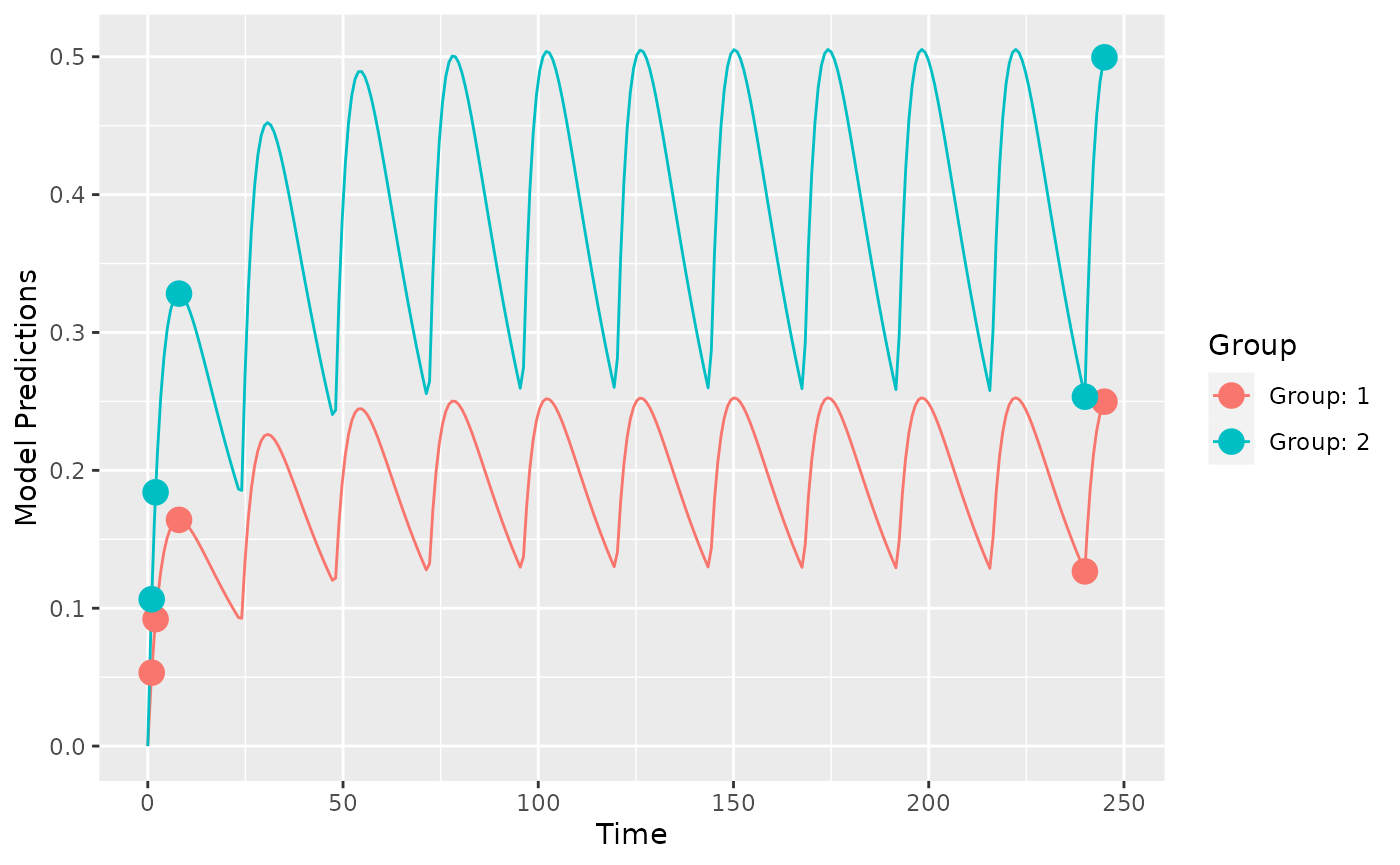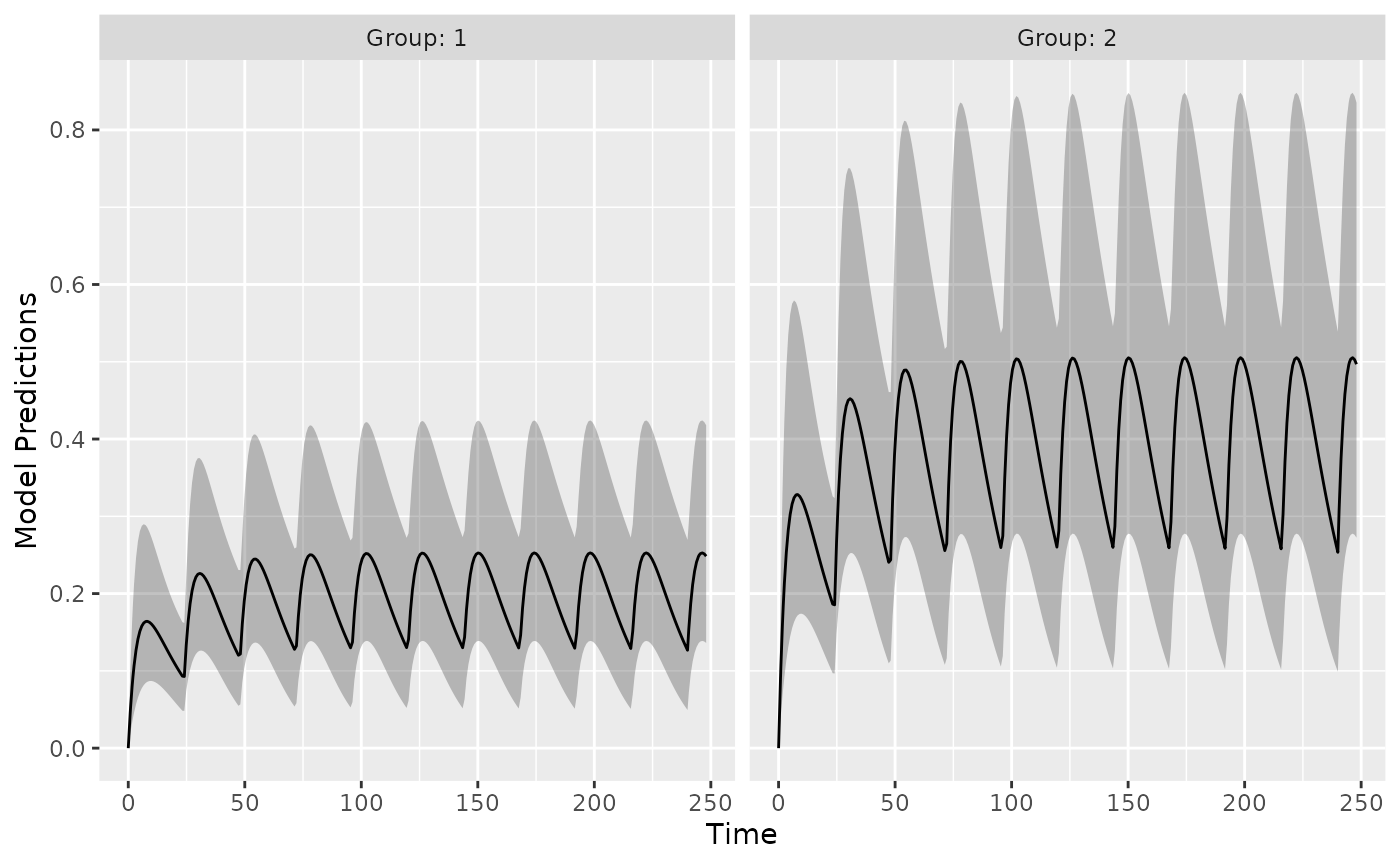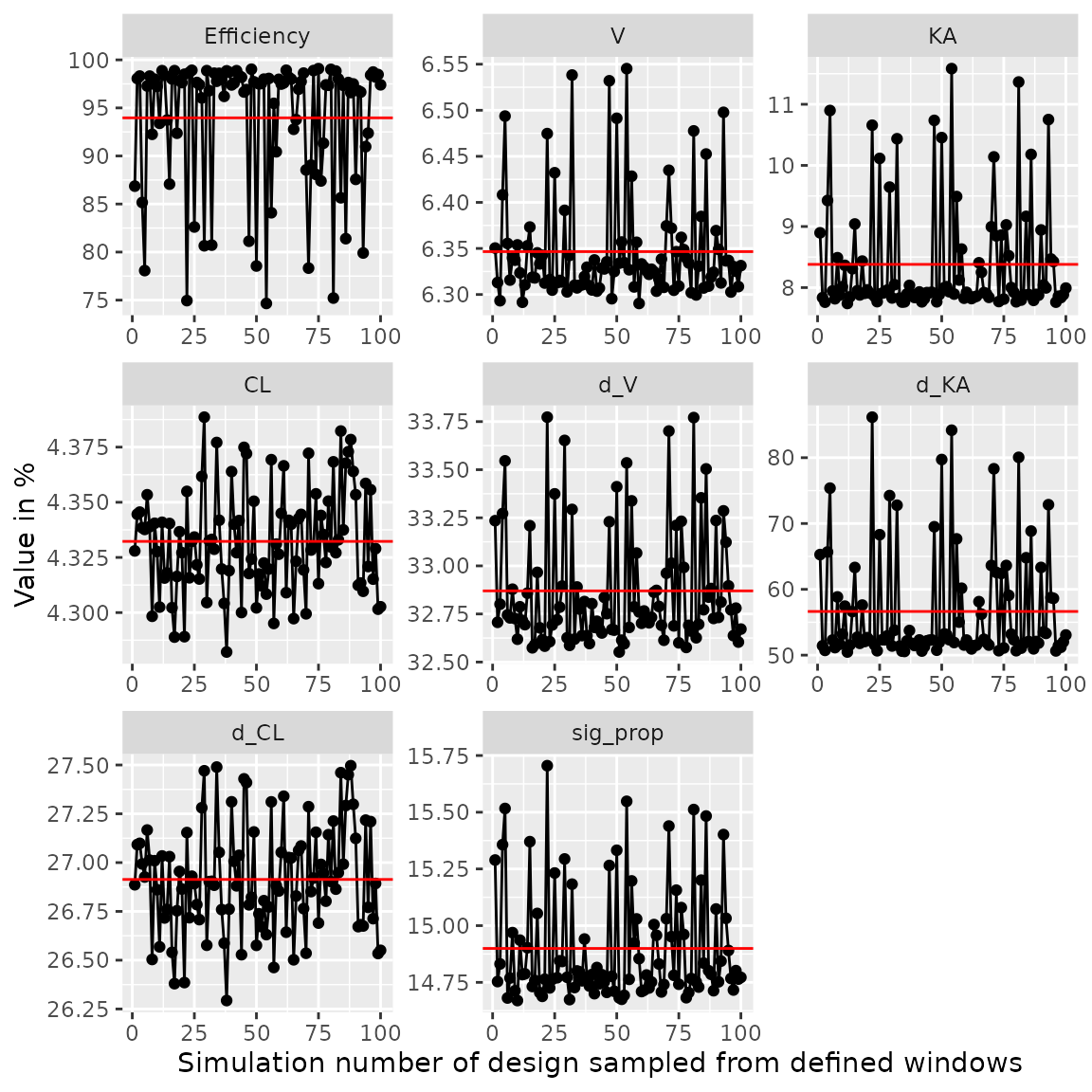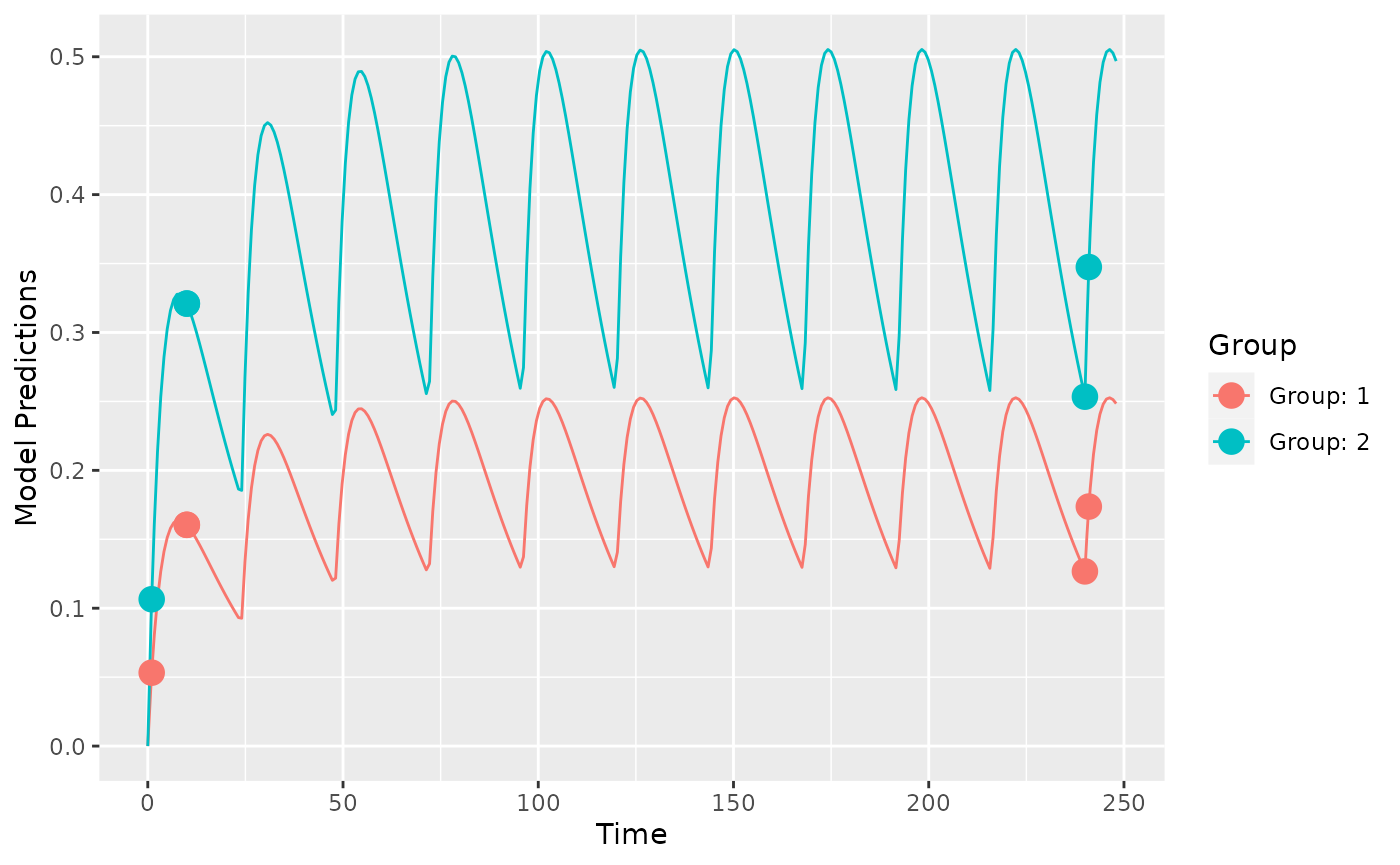PopED computes optimal experimental designs for both population and individual studies based on nonlinear mixed-effect models. Often this is based on a computation of the Fisher Information Matrix (FIM).
To get started you need to define
- A model.
- An initial design (and design space if you want to optimize)
- The tasks to perform.
There are a number of functions to help you with these tasks. See
?poped for more information.
Below is an example to introduce the package. Several other examples are available as r-scripts in the “examples” folder in the PopED installation directory located at:
system.file("examples", package="PopED")You can view a list of the example files using the commands:
ex_dir <- system.file("examples", package="PopED")
list.files(ex_dir)You can then open one of the examples (for example,
ex.1.a.PK.1.comp.oral.md.intro.R, is very similar to the
code found in this vignette) using the following code
file_name <- "ex.1.a.PK.1.comp.oral.md.intro.R"
ex_file <- system.file("examples",file_name,package="PopED")
file.copy(ex_file,tempdir(),overwrite = T)
file.edit(file.path(tempdir(),file_name))In addition, there is another vignette called “Examples” that explores the new features in each example.
Define a model
Here we define a one-compartment pharmacokinetic model with linear
absorption using an analytical solution. In this case the solution is
applicable for both multiple and single dosing. Note that this function
is also predefined in PopED as ff.PK.1.comp.oral.md.CL (see
?ff.PK.1.comp.oral.md.CL for more information).
library(PopED)
packageVersion("PopED")
#> [1] '0.7.0'
ff <- function(model_switch,xt,parameters,poped.db){
with(as.list(parameters),{
N = floor(xt/TAU)+1
f=(DOSE*Favail/V)*(KA/(KA - CL/V)) *
(exp(-CL/V * (xt - (N - 1) * TAU)) * (1 - exp(-N * CL/V * TAU))/(1 - exp(-CL/V * TAU)) -
exp(-KA * (xt - (N - 1) * TAU)) * (1 - exp(-N * KA * TAU))/(1 - exp(-KA * TAU)))
return(list( f=f,poped.db=poped.db))
})
}Next we define the parameters of this function, in this case the
between-subject variability (BSV) for each parameter is log-normally
distributed (parameter Favail is assumed not to have BSV).
DOSE and TAU are defined as covariates (in
vector a) so that we can optimize their values later.
sfg <- function(x,a,bpop,b,bocc){
parameters=c( V=bpop[1]*exp(b[1]),
KA=bpop[2]*exp(b[2]),
CL=bpop[3]*exp(b[3]),
Favail=bpop[4],
DOSE=a[1],
TAU=a[2])
}Now we define the residual unexplained variability (RUV) function, in this case the RUV has both an additive and proportional component.
Create a PopED database
We create a poped database to link the model defined above with a set of model parameters, the initial design and design space for optimization.
In this example, the parameter values are defined for the fixed
effects (bpop), the between-subject variability variances
(d) and the residual variability variances
(sigma). We also fix the parameter Favail
using notfixed_bpop, since we have only oral dosing and the
parameter is not identifiable. Fixing a parameter means that we assume
the parameter will not be estimated (and is know without uncertainty).
In addition, we fix the small additive RUV term, as this term is
reflecting the higher error expected at low concentration measurements
(limit of quantification measurements) and would typically be calculated
from analytical assay methods (for example, the standard deviation of
the parameter might be 20% of the limit of quantification).
For the initial design, we define two groups (m=2) of 20
individuals (groupsize=20), with doses of 20 mg or 40 mg
every 24 hours (a). The initial design has 5 sample times
per individual (xt).
For the design space, which can be searched during optimization, we
define a potential dose range of between 0 and 200 mg (mina
and maxa), and a range of potential sample times between 0
and 10 hours for the first three samples and between 240 and 248 hours
for the last two samples (minxt and maxxt).
Finally, we fix the two groups of subjects to have the same sample times
(bUseGrouped_xt=TRUE).
poped.db <- create.poped.database(
# Model
ff_fun=ff,
fg_fun=sfg,
fError_fun=feps,
bpop=c(V=72.8,KA=0.25,CL=3.75,Favail=0.9),
notfixed_bpop=c(1,1,1,0),
d=c(V=0.09,KA=0.09,CL=0.25^2),
sigma=c(prop=0.04,add=5e-6),
notfixed_sigma=c(1,0),
# Design
m=2,
groupsize=20,
a=list(c(DOSE=20,TAU=24),c(DOSE=40, TAU=24)),
maxa=c(DOSE=200,TAU=24),
mina=c(DOSE=0,TAU=24),
xt=c( 1,2,8,240,245),
# Design space
minxt=c(0,0,0,240,240),
maxxt=c(10,10,10,248,248),
bUseGrouped_xt=TRUE)Design simulation
First it may make sense to check your model and design to make sure you get what you expect when simulating data. Here we plot the model typical values:
plot_model_prediction(poped.db, model_num_points = 300)
Next, we plot the expected prediction interval (by default a 95% PI)
of the data taking into account the BSV and RUV using the option
PI=TRUE. This option makes predictions based on first-order
approximations to the model variance and a normality assumption of that
variance. Better (and slower) computations are possible with the
DV=T, IPRED=T and
groupsize_sim = some large number options.
plot_model_prediction(poped.db,
PI=TRUE,
separate.groups=T,
model_num_points = 300,
sample.times = FALSE)
We can get these predictions numerically as well:
dat <- model_prediction(poped.db,DV=TRUE)
head(dat,n=5);tail(dat,n=5)
#> ID Time DV IPRED PRED Group Model DOSE TAU
#> 1 1 1 0.09659927 0.08034839 0.05325024 1 1 20 24
#> 2 1 2 0.13172074 0.13415072 0.09204804 1 1 20 24
#> 3 1 8 0.19502544 0.19134279 0.16409609 1 1 20 24
#> 4 1 240 0.04847782 0.05881203 0.12671376 1 1 20 24
#> 5 1 245 0.29770447 0.23457544 0.24980320 1 1 20 24
#> ID Time DV IPRED PRED Group Model DOSE TAU
#> 196 40 1 0.04411438 0.0583122 0.1065005 2 1 40 24
#> 197 40 2 0.10599655 0.1039377 0.1840961 2 1 40 24
#> 198 40 8 0.20262746 0.2206604 0.3281922 2 1 40 24
#> 199 40 240 0.17506051 0.3788561 0.2534275 2 1 40 24
#> 200 40 245 0.56558539 0.5183551 0.4996064 2 1 40 24Design evaluation
Next, we evaluate the initial design
(ds1 <- evaluate_design(poped.db))
#> $ofv
#> [1] 39.309
#>
#> $fim
#> V KA CL d_V d_KA d_CL
#> V 0.05336692 -8.683963 -0.05863412 0.000000 0.000000 0.000000
#> KA -8.68396266 2999.851007 -14.43058560 0.000000 0.000000 0.000000
#> CL -0.05863412 -14.430586 37.15243290 0.000000 0.000000 0.000000
#> d_V 0.00000000 0.000000 0.00000000 999.953587 312.240246 3.202847
#> d_KA 0.00000000 0.000000 0.00000000 312.240246 439.412556 2.287838
#> d_CL 0.00000000 0.000000 0.00000000 3.202847 2.287838 3412.005199
#> sig_prop 0.00000000 0.000000 0.00000000 575.347261 638.581909 1182.325475
#> sig_prop
#> V 0.0000
#> KA 0.0000
#> CL 0.0000
#> d_V 575.3473
#> d_KA 638.5819
#> d_CL 1182.3255
#> sig_prop 33864.3226
#>
#> $rse
#> V KA CL d_V d_KA d_CL sig_prop
#> 8.215338 10.090955 4.400304 39.844763 60.655110 27.562541 13.865357We see that the fixed-effect and residual variability parameters are relatively well estimated with this design, but the between-subject variability parameters are less well estimated.
Evaluate alternative design
What about an alternative design with sparse sampling? For example, what if each individual only has 3 time points at 1, 2 and 245 hours:
poped.db.new <- create.poped.database(
# Model
ff_fun=ff,
fg_fun=sfg,
fError_fun=feps,
bpop=c(V=72.8,KA=0.25,CL=3.75,Favail=0.9),
notfixed_bpop=c(1,1,1,0),
d=c(V=0.09,KA=0.09,CL=0.25^2),
sigma=c(prop=0.04,add=5e-6),
notfixed_sigma=c(1,0),
# Design
m=2,
groupsize=20,
a=list(c(DOSE=20,TAU=24),c(DOSE=40, TAU=24)),
maxa=c(DOSE=200,TAU=24),
mina=c(DOSE=0,TAU=24),
xt=c( 1,2,245),
# Design space
minxt=c(0,0,240),
maxxt=c(10,10,248),
bUseGrouped_xt=TRUE)
(ds2 <- evaluate_design(poped.db.new))
#> $ofv
#> [1] 29.66484
#>
#> $fim
#> V KA CL d_V d_KA d_CL
#> V 0.04243232 -10.51432 0.05782431 0.000000 0.000000 0.000000
#> KA -10.51432135 2666.25466 -14.66678102 0.000000 0.000000 0.000000
#> CL 0.05782431 -14.66678 21.59743298 0.000000 0.000000 0.000000
#> d_V 0.00000000 0.00000 0.00000000 632.163776 457.737062 3.115099
#> d_KA 0.00000000 0.00000 0.00000000 457.737062 347.115999 2.363458
#> d_CL 0.00000000 0.00000 0.00000000 3.115099 2.363458 1153.026981
#> sig_prop 0.00000000 0.00000 0.00000000 348.477101 262.369792 1979.231386
#> sig_prop
#> V 0.0000
#> KA 0.0000
#> CL 0.0000
#> d_V 348.4771
#> d_KA 262.3698
#> d_CL 1979.2314
#> sig_prop 15617.8185
#>
#> $rse
#> V KA CL d_V d_KA d_CL sig_prop
#> 44.120338 51.256239 5.748842 207.941540 280.689945 53.350716 22.795275Comparison of designs
The precision on CL is similar with the alternative design but the other parameters are less well estimated.
(design_eval <- round(data.frame("Design 1"=ds1$rse,"Design 2"=ds2$rse)))| Design.1 | Design.2 | |
|---|---|---|
| V | 8 | 44 |
| KA | 10 | 51 |
| CL | 4 | 6 |
| d_V | 40 | 208 |
| d_KA | 61 | 281 |
| d_CL | 28 | 53 |
| sig_prop | 14 | 23 |
Comparing the objective function value (OFV), we see that the alternative design (less samples per subject) has a smaller OFV (=worse). We can compare the two OFVs using efficiency, which tells us the proportion extra individuals that are needed in the alternative design to have the same information content as the original design (around 4 times more individuals than are currently in the design).
efficiency(ds2$ofv,ds1$ofv,poped.db)
#> [1] 3.965919
#> attr(,"description")
#> [1] "(exp(ofv_final) / exp(ofv_init))^(1/n_parameters)"Design optimization
Now we can optimize the sample times of the original design by maximizing the OFV1.
output <- poped_optim(poped.db, opt_xt=TRUE)
summary(output)
#> ===============================================================================
#> FINAL RESULTS
#> Optimized Sampling Schedule
#> Group 1: 0.4573 10 10 240 240.9
#> Group 2: 0.4573 10 10 240 240.9
#>
#> OFV = 40.5277
#>
#> Efficiency:
#> ((exp(ofv_final) / exp(ofv_init))^(1/n_parameters)) = 1.1902
#>
#> Expected relative standard error
#> (%RSE, rounded to nearest integer):
#> Parameter Values RSE_0 RSE
#> V 72.8 8 6
#> KA 0.25 10 8
#> CL 3.75 4 4
#> d_V 0.09 40 33
#> d_KA 0.09 61 50
#> d_CL 0.0625 28 26
#> sig_prop 0.04 14 15
#>
#> Total running time: 16.423 seconds
plot_model_prediction(output$poped.db)
We see that there are four distinct sample times for this design. This means that for this model, with these exact parameter values, that the most information from the study to inform the parameter estimation is with these sample times.
Examine efficiency of sampling windows
Of course, this means that there are multiple samples at some of these time points. We can explore a more practical design by looking at the loss of efficiency if we spread out sample times in a uniform distribution around these optimal points ( minutes).
plot_efficiency_of_windows(output$poped.db,xt_windows=0.5)
Here we see the efficiency
()
drops below 80% in some cases, which is mostly caused by an increase in
the parameter uncertainty of the BSV parameter on absorption (om_KA).
Smaller windows or different windowing on different samples might be
needed. To investigate see ?plot_efficiency_of_windows.
Optimize over a discrete design space
In the previous example we optimized over a continuous design space (sample times could be optimized to be any value between a lower and an upper limit). We could also limit the search to only “allowed” values, for example, only samples taken on the hour are allowed.
poped.db.discrete <- create.poped.database(poped.db,discrete_xt = list(c(0:10,240:248)))
output_discrete <- poped_optim(poped.db.discrete, opt_xt=TRUE)
summary(output_discrete)
#> ===============================================================================
#> FINAL RESULTS
#> Optimized Sampling Schedule
#> Group 1: 1 10 10 240 241
#> Group 2: 1 10 10 240 241
#>
#> OFV = 40.3782
#>
#> Efficiency:
#> ((exp(ofv_final) / exp(ofv_init))^(1/n_parameters)) = 1.165
#>
#> Expected relative standard error
#> (%RSE, rounded to nearest integer):
#> Parameter Values RSE_0 RSE
#> V 72.8 8 6
#> KA 0.25 10 8
#> CL 3.75 4 4
#> d_V 0.09 40 32
#> d_KA 0.09 61 53
#> d_CL 0.0625 28 27
#> sig_prop 0.04 14 15
#>
#> Total running time: 10.068 seconds
plot_model_prediction(output_discrete$poped.db, model_num_points = 300)
Here we see that the optimization ran somewhat quicker, but gave a less efficient design.
Optimize ‘Other’ design variables
One could also optimize over dose, to see if a different dose could help in parameter estimation .
output_dose_opt <- poped_optim(output$poped.db, opt_xt=TRUE, opt_a=TRUE)In this case the results are predictable … higher doses give observations with somewhat lower absolute residual variability leading to both groups at the highest allowed dose levels (200 mg in this case).
Cost function to optimize dose
Optimizing the dose of a study just to have better model parameter estimates may be somewhat implausible. Instead, let’s use a cost function to optimize dose based on some sort of target concentration … perhaps typical population trough concentrations of 0.2 and 0.35 for the two groups of patients at 240 hours.
First we define the criteria we use to optimize the doses, here a least squares minimization.
crit_fcn <- function(poped.db,...){
pred_df <- model_prediction(poped.db)
sum((pred_df[pred_df["Time"]==240,"PRED"] - c(0.2,0.35))^2)
}
crit_fcn(output$poped.db)
#> [1] 0.01469712Now we minimize the cost function
output_cost <- poped_optim(poped.db, opt_a = TRUE, opt_xt = FALSE,
ofv_fun=crit_fcn,
maximize = FALSE)
summary(output_cost)
#> ===============================================================================
#> FINAL RESULTS
#>
#> Optimized Covariates:
#> Group 1: 31.5672 : 24
#> Group 2: 55.2426 : 24
#>
#> OFV = 6.09293e-15
#>
#> Efficiency:
#> (ofv_final / ofv_init) = 4.1457e-13
#>
#> Expected relative standard error
#> (%RSE, rounded to nearest integer):
#> Parameter Values RSE_0 RSE
#> V 72.8 8 8
#> KA 0.25 10 10
#> CL 3.75 4 4
#> d_V 0.09 40 40
#> d_KA 0.09 61 60
#> d_CL 0.0625 28 28
#> sig_prop 0.04 14 14
#>
#> Total running time: 3.617 secondsWe see that the optimal doses are 31.6 and 55.2 for the two groups. This leads to population trough concentrations of 0.2 and 0.35 for the two groups of patients at 240 hours:
library(ggplot2)
plot_model_prediction(output_cost$poped.db, model_num_points = 300)+
coord_cartesian(xlim=c(230,250))
